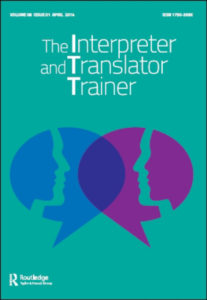[CFP] The Interpreter and Translator Trainer Special Issue on Training signed language interpreters and translators
 Special Issue Editor(s)
Special Issue Editor(s)
Maya de Wit, Independent Researcher, Netherlands
maya@tolkngt.nl
Sabine Fries, University of Applied Sciences Landshut, SLI, Germany
sabine.fries@haw-landshut.de
Irene Strasly, Faculty of Translation and Interpreting, University of Geneva, Switzerland
irene.strasly@unige.ch
Training signed language interpreters and translators
Training of signed language interpreters began already in the 1920s in Russia. Nowadays, interpreters in signed languages are generally trained to work in community settings as all-round interpreters in dialogue interpreting. Throughout the last decades we see an increase in the number of signed language interpreter training programs. However, dedicated academic training in translation, rather than interpretation, of signed languages is rare. The urgent need for qualified signed language translations was highlighted during the Covid-19 pandemic, as accessible health care information for signers became crucial. Like the translation of written languages, translation into signed languages requires specific competences, which are different from those required for interpreting. Nevertheless, so far, relatively little has been documented regarding best practices in signed language translation, its essential competences, and best practices on how to train signed language interpreters.
The professionalization of the interpreting profession during the last decades has transformed previous ad hoc training into current three- or four-year bachelor university level programs. Students are generally trained to become interpreters between their national sign language and the national spoken language. However, other than with the training of spoken language interpreters, most students entering such programs do not know the national sign language. Consequently, a substantial part of the curriculum is dedicated to signed language acquisition. Additionally, critical discourses in the field, for instance, on power mechanisms in the relationship between future interpreters and their clients, should constitute an integral part of the training in the form of reflective practices. Overall, designing a curriculum to train signed language interpreters based on user demands as well as best practices, has been a continuous discussion among educators, researchers, and practitioners.
A pressing issue in the education of signed language translators and interpreters is the continuous inaccessibility of the existing programs. The programs were originally designed for hearing signed language interpreters to work between their spoken and signed language. Inaccessibility persists for deaf individuals in certain countries due to the barriers in accessing tertiary education. In summary, very few of the programs have made the changes to meet the current demand in the field and allow for the joint training of deaf and hearing signed language interpreters. Yet there are compelling reasons to reconsider the feasibility of such joint training programs.
The evolution of technology gives opportunities to develop innovative training methods, both for hearing and deaf professionals who work as signed language interpreters/translators, such as distance-mode teaching. The increase in the number of remote events has also increased the demand for interpreters and translators who provide their services from a distance. Distance interpreting asks additional demands from the interpreter/translator, and these demands include cognitive skills as well as technological savviness. These relatively new forms of service have not been extensively researched and are not incorporated in the training of interpreters and translators.
In this special issue we seek to present evidence-based practices that could provide further guidance in the training of signed language interpreters and translators. We welcome contributions that describe actual professional as well as teaching practices in an attempt to understand where we are at in terms of training and where we are going.
Themes that may be addressed include (but are not restricted to) the following:
- training deaf translators and/or deaf interpreters (such as curriculum design, teaching methods to mixed deaf-hearing classes or to deaf-only classes)
- incorporating ethical dimensions in training signed language interpreters and translators (how the subject of ethics is approached in class; how the use of technology is discussed with students; and how the discourses on power dynamics and mechanisms are integrated in the teaching)
- use and impact of technology in training signed language interpreters and translators (for example, synchronous and asynchronous ways of teaching through online platforms)
- innovative applications in training the collected best practices in AI tools and technological innovations for interpreting and translation
- training of trainers: educating practitioners in becoming a trainer or mentor
- collaborative practices: how to manage and ensure stakeholder representation in sign language interpreting and translating programs
Submission Instructions
We invite original and up-to-date contributions that do not exceed 8000 words (tables, captions, references, footnotes and endnotes included) and that reach out to an international readership. All papers will be subject to double-blind peer review. The focus of all submission should be within the scope of The Interpreter and Translator Trainer.
Schedule for publication
| 20 June 2024 | Deadline for the submission of abstracts (500 words) to guest editors via email at maya@tolkngt.nl, sabine.fries@haw-landshut.de, irene.strasly@unige.ch |
| 20 July 2024 | Selected contributors notified of the provisional acceptance of abstracts |
| 30 Nov 2024 | Deadline for the submission of full papers via the journal’s submissions system |
| Dec 2024 – March 2025 | First round of double-blind peer review |
| April 2025 | Notification of the outcome of the first round of peer-review; papers short-listed for provisional acceptance |
| April 2025 – July 2025 | Authors submit revised versions (via the submissions system); second round of peer-review |
| 1 Aug 2025 | Deadline for submission of final versions of papers (via the submissions system) |
| Sept 2025 | Final editing and proofreading |
| Dec 2025 | Publication |
